Brazo de Mercedes is a traditional Filipino dessert that consists of a soft and pillowy meringue roll filled with sweet and sticky egg custard. The combination is so good! Light and airy meringue that melts-in-your-mouth followed by rich and decadent yema. A real treat.
(Try this Brazo de Mercedes cupcake recipe if you’re not in a cake rolling mood today. It’s equally delicious and has video step-by-step instructions.)
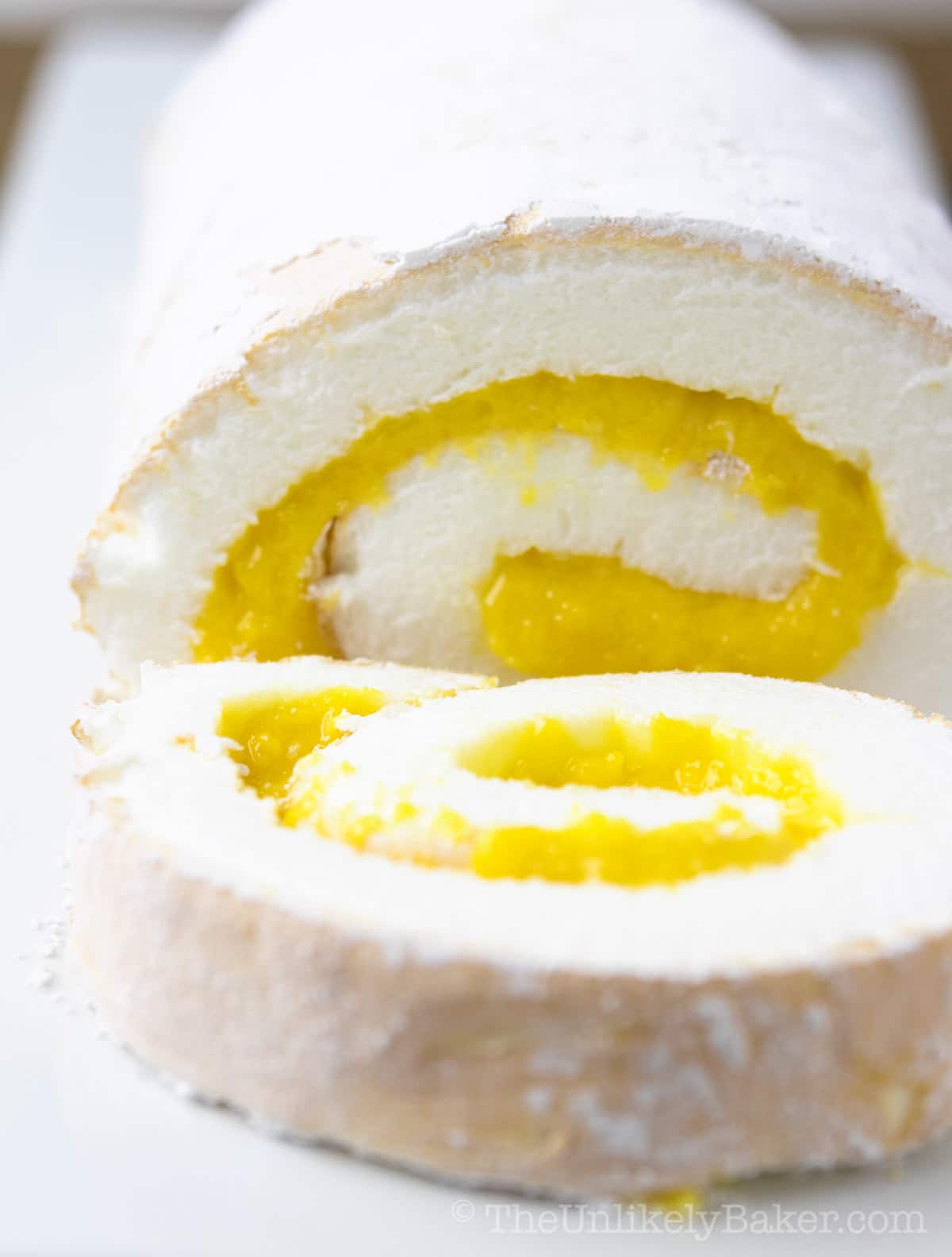
This was the recipe that started it all.
Brazo de Mercedes got me into baking and blogging all those years ago.
I haven’t perfected the recipe then (scroll to see an image of what it looked like before) but I shared it on The Unlikely Baker anyway because I loved the symbolism of this cake being the first ever recipe I posted on a blog that it inspired.
I haven’t touched it since because I spent all these years recipe testing. Seriously. And I failed. A lot.
But I learned a lot, too. And now I’m finally ready to share all my brazo making knowledge with all of you.
Let’s get to it.
What is Brazo de Mercedes
These days, you can find Brazo de Mercedes with ube or mango filling; you can even find brazo ice cream and frozen brazo.
But I would always choose the original Brazo de Mercedes cake over all its modern variations.
In english, the name loosely translates to “Mercedes’ arm”. I suppose because the log looks like an arm? Regardless, like a lot of Filipino food, it can trace its origins back to Spanish times.
I found this really interesting article about its history — something about egg yolks being thrown into a river and Filipino ingenuity. Check it out. It’s quite the fascinating read.
In any case, Brazo de Mercedes has become quintessentially Filipino since. It’s what you have on the dinner table when you’re celebrating something. And Filipinos are always celebrating something.
So I grew up eating it and I’ve always associated it with happy, family gatherings.
Why you’ll love making it
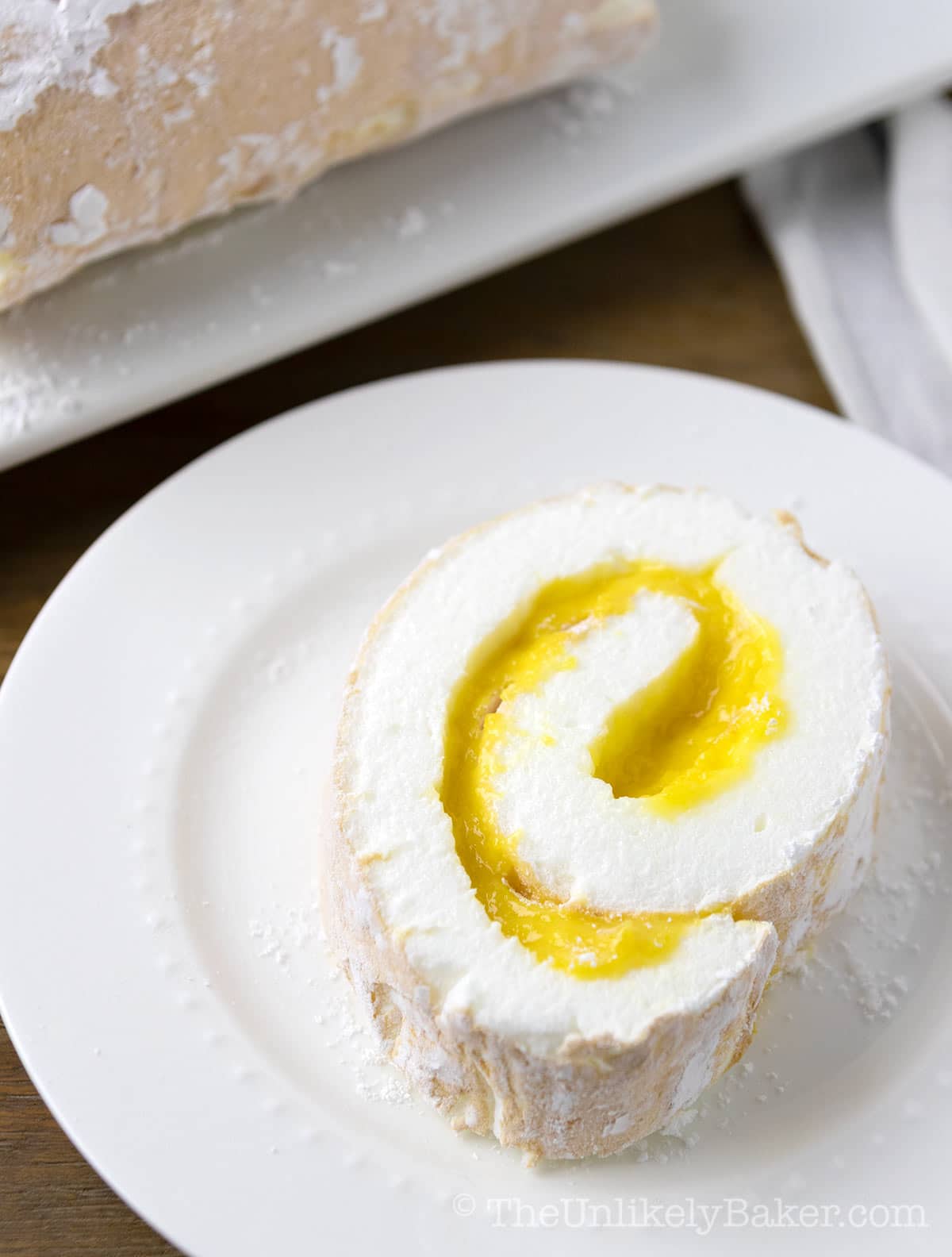
When I was new to Canada, I couldn’t find brazo anywhere so I taught myself to make it at home.
There are more places that sell it now but they’re quite pricey and not even close to the deliciousness we are used to from the Red Ribbon and Goldilocks cakes of old.
So I just aways make my own and love it. You’ll love making it too because:
- It’s easier to make than you think. The recipe has lots of steps and meringue is always finicky to make but I give lots of tips to avoid all the common pitfalls. And if you break down each step into small, manageable parts, it’s really easy-peasy.
- Homemade brazo tastes better than store-bought ones. And it’s way cheaper to make too. Around here, a half log of brazo costs upwards of $60. At today’s exchange rate, that’s almost 2,500 Philippine pesos!
- It’s so satisfying to bake. Something about being able to bake this amazing cake is so satisfying. Slicing into it, that first bite, it makes you really proud as a baker. And a Filipino!
How to make it at home
Brazo de Mercedes has two components — the meringue and the filling. And it takes less than 10 ingredients to make both.
Ingredients
This recipe doesn’t contain flour. But is has the usual eggs, vanilla extract, granulated sugar and salt. Some key things to note about the others:
- Cream of tartar — this helps stabilize the egg whites. I don’t make this recipe without cream of tartar but if that’s not available, suitable alternatives include 1 teaspoon of vinegar or lemon juice for every ½ teaspoon of cream of tartar.
- Sweetened condensed milk — I often say sweetened in relation to condensed milk but I learned recently that’s redundant. Unsweetened condensed milk is actually just evaporated milk! So let’s make sure to buy condensed milk for this recipe.
- Lime juice — lime juice helps cut through the sweetness of the custard filling. If you can find dayap where you are, use that. It’s what is traditionally used in a Brazo de Mercedes recipe.
- Confectioner’s sugar — sometimes called powdered sugar or icing sugar. You can’t substitute regular sugar in this case. It’s easy enough to make at home though. Check out this recipe.
Tools
In my recipe-testing, I’ve found that the best pan to use when making Brazo de Mercedes is a 10×15 inch jelly roll pan.
If you don’t have that, the second best pan to use would be a 9×13 inch pan. I won’t go any bigger than that; otherwise, your meringue will come out too flat.
In addition, I also use a stand mixer to make the meringue but a handheld electric mixer will work too.
You’ll also need:
- Bowls
- Measuring cups and spoons
- Another baking sheet or pan to help flip the cake
- Wax paper for rolling (parchment paper will work too)
- Mesh sieve for sprinkling confectioner’s sugar
- Sauce pan to make the custard filling
Recipe with step-by-step photos
How to make the yema filling
I always start with the filling. This way, I give my egg whites time to come down to room temperature before I make the meringue.
In a medium, heavy-bottom saucepan (off the stove), combine egg yolks, condensed milk and a pinch of salt. Mix thoroughly then start cooking over low heat.
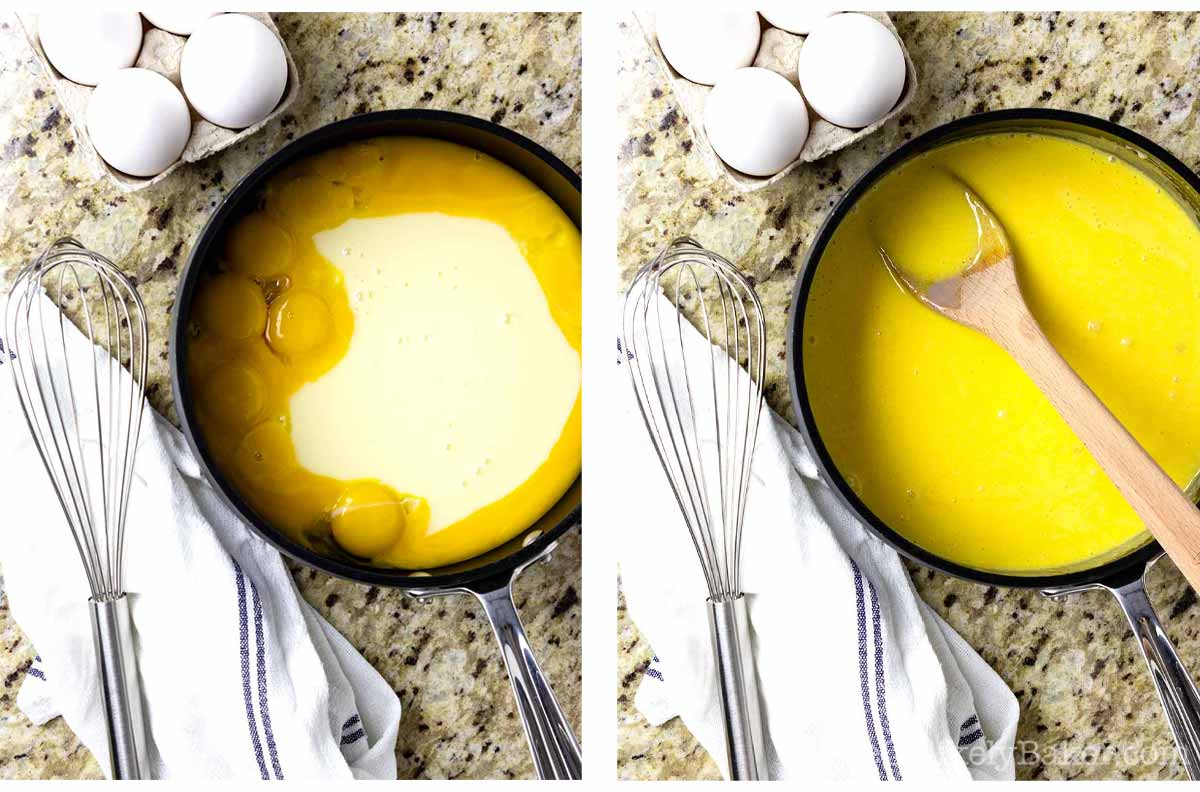
Stir often so the eggs don’t scramble or burn. When the custard starts to thicken and take shape, add vanilla extract and lime juice and continue stirring until you get your desired consistency (thick but still easily spreadable). Transfer to a heat proof container and allow to cool.
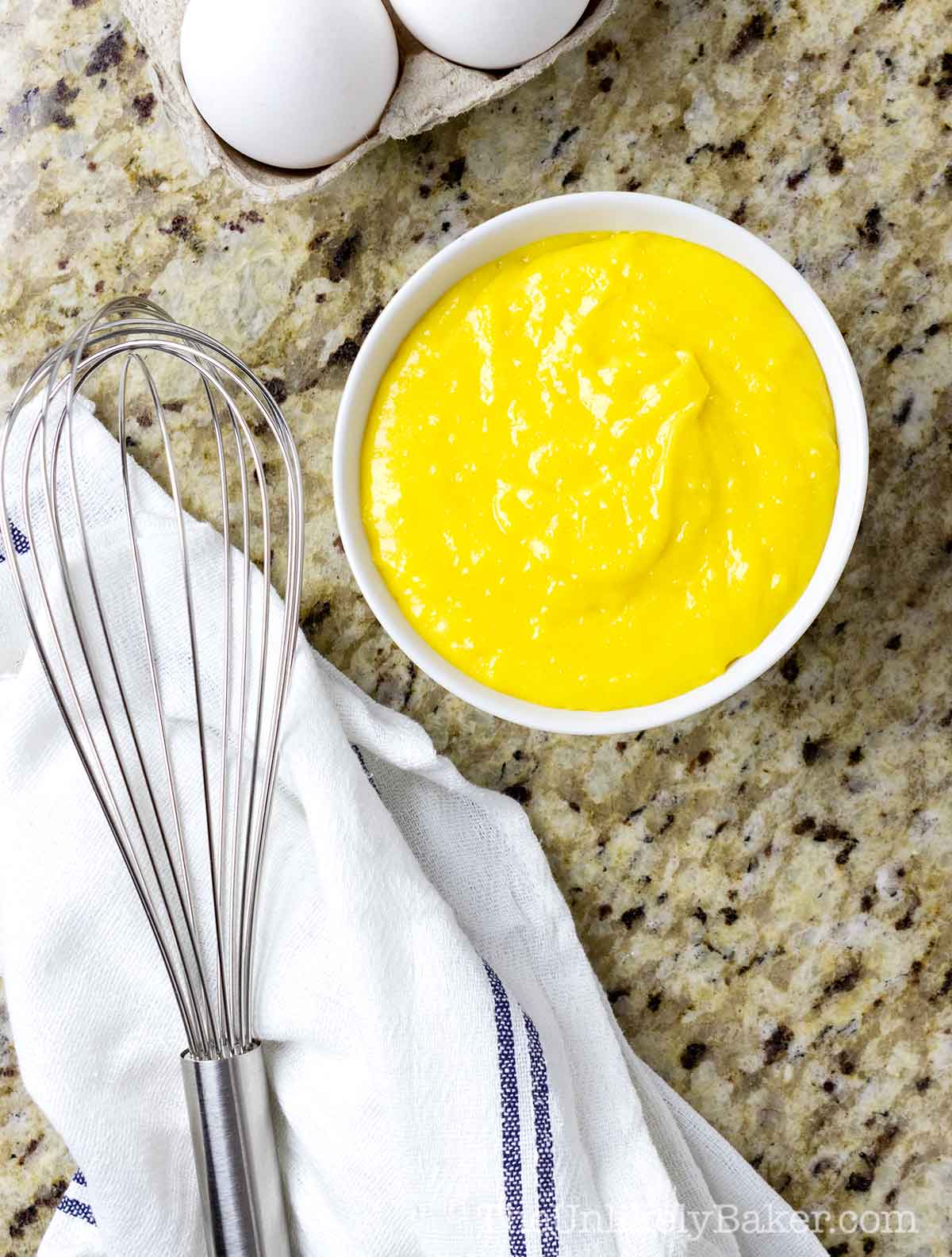
How to make the meringue
Preheat your oven to 350F. Prep a 10×15 jelly roll pan by lining it with parchment paper then greasing the parchment paper. Set aside.
In a large bowl using a handheld electric mixer or using a stand mixer fitted with the whisk attachment, combine egg whites and cream of tartar and whisk on low-medium speed until foamy. Gradually add sugar — about 1 teaspoon at time — until stiff peaks form.
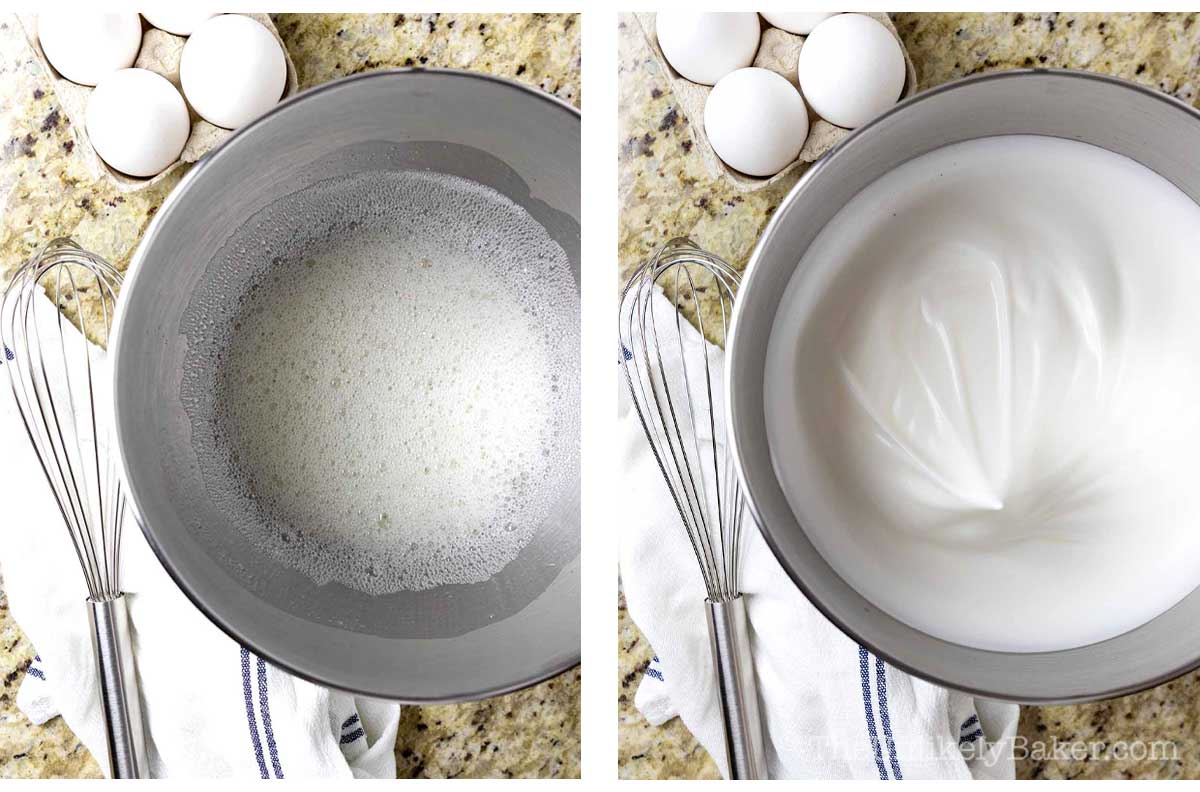
Transfer the meringue to your prepared pan and spread evenly. Remember to handle lightly so as not to deflate the meringue.
Optional: Brazo de Mercedes traditionally has a zigzagged surface and you can achieve this by levelling the top of your meringue with a decorating comb or a fork. I personally don’t like doing this because I end up losing a significant amount of meringue so I just skip this step.
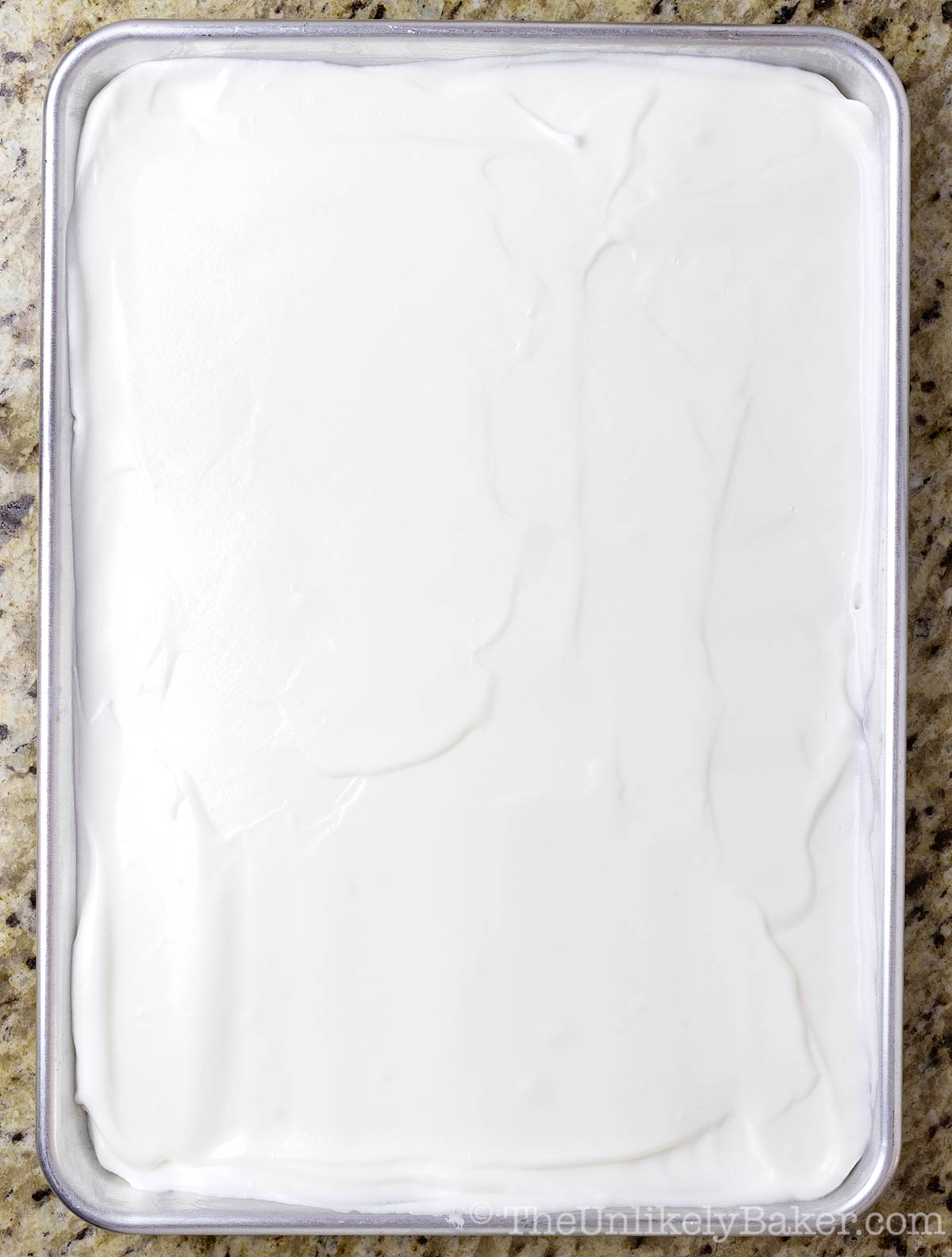
Bake for 20 minutes or until the top turns a light brown. Turn the oven off, open the oven door slightly, and keep the meringue in the oven for another 10 minutes to allow it to cool gradually before removing.
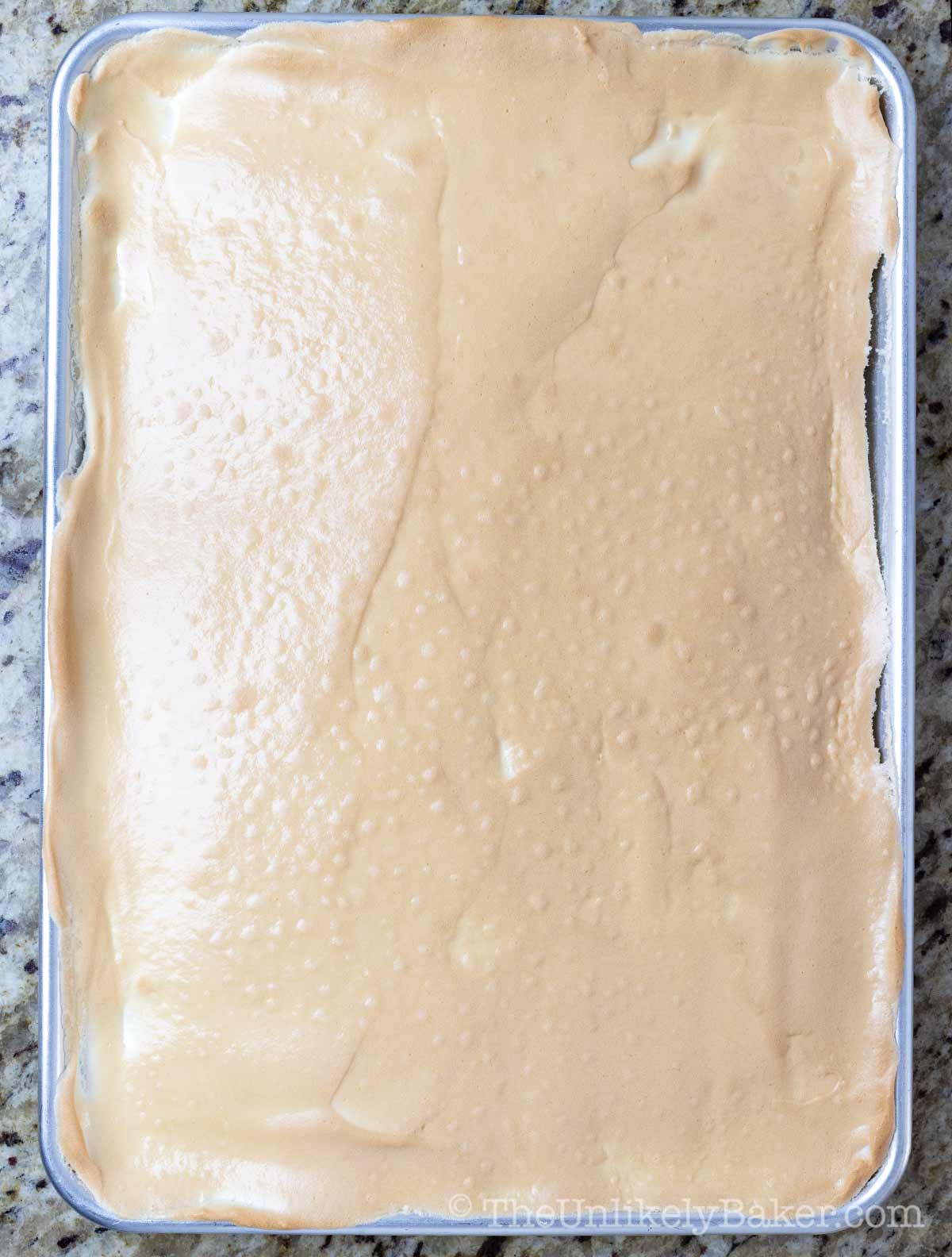
Rolling the cake
Allow the baked meringue to cool on the counter before gently running a thin sharp knife around the edges of the pan and thoroughly sprinkling with confectioner’s sugar. Place a piece of wax paper on top of the meringue, then cover the meringue with another pan that’s slightly larger than the pan you baked the meringue in.
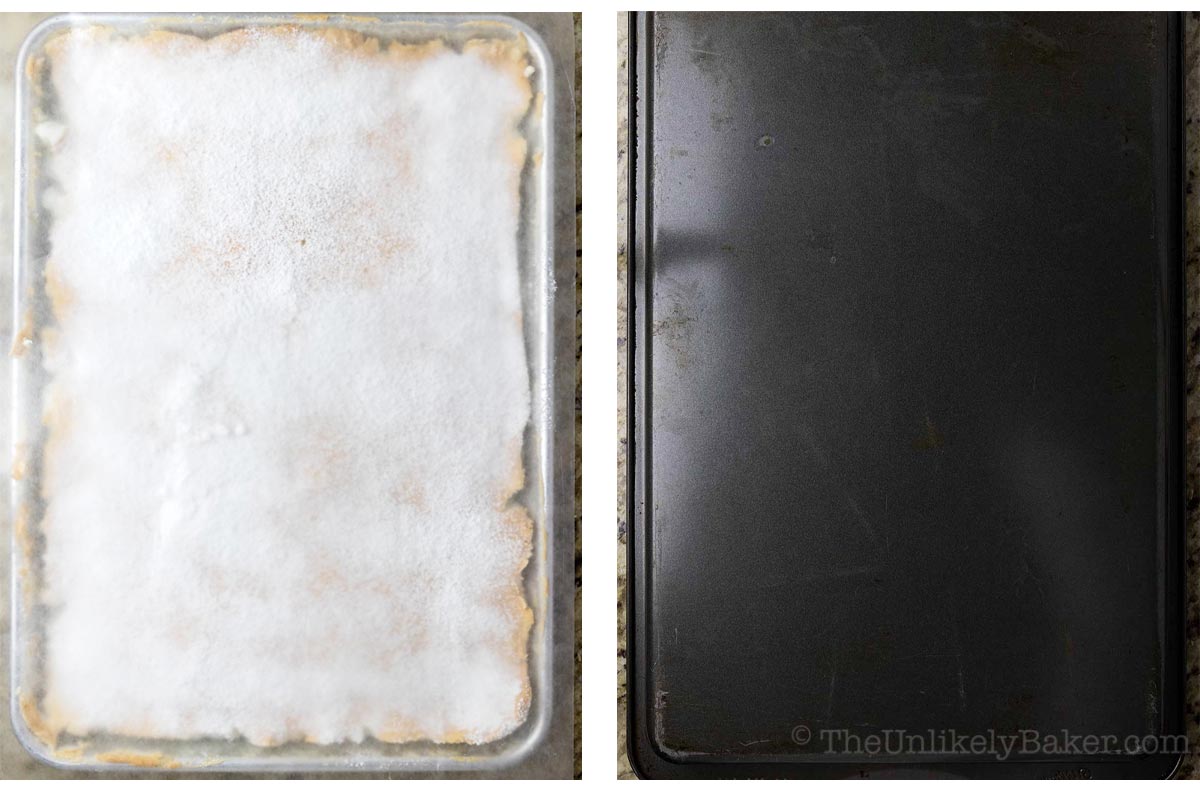
Carefully flip the cake, lift the jelly roll pan and gently peel the parchment paper off the meringue.
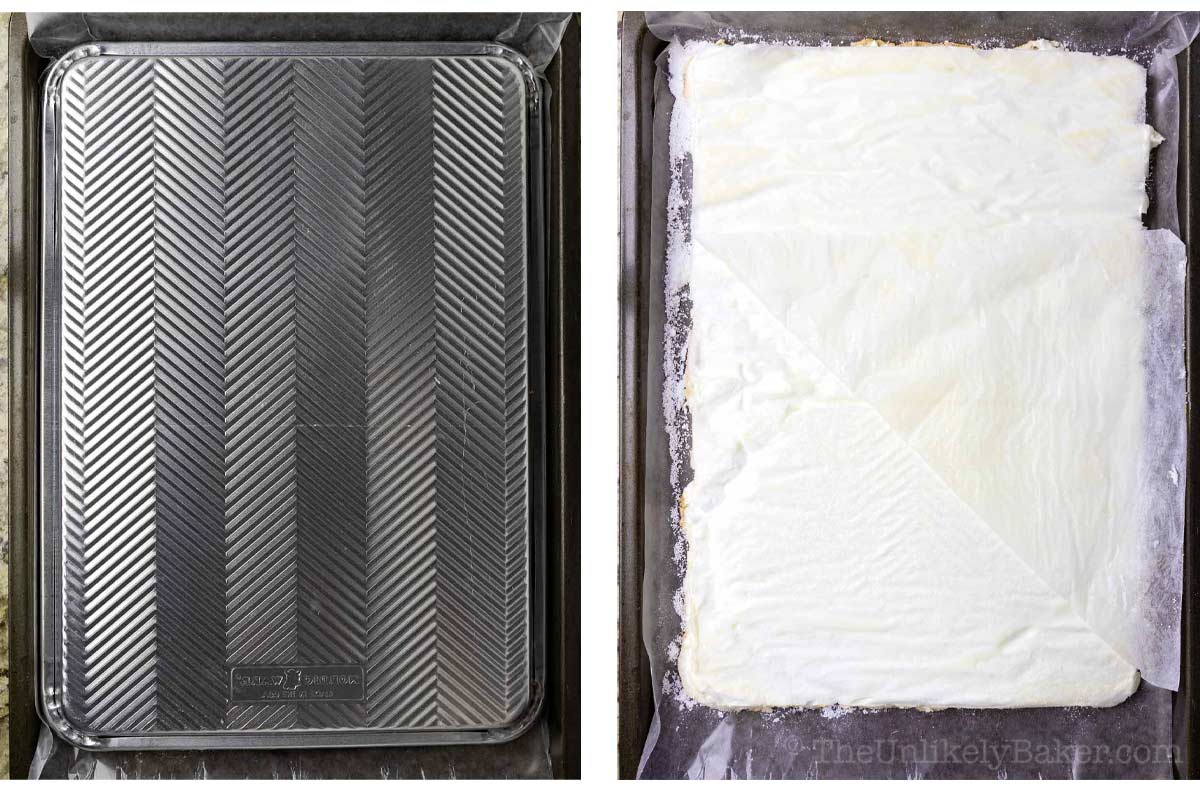
Spread the custard evenly then use the wax paper to help you roll the meringue over. Cover in wax paper until ready to serve. Best served immediately.
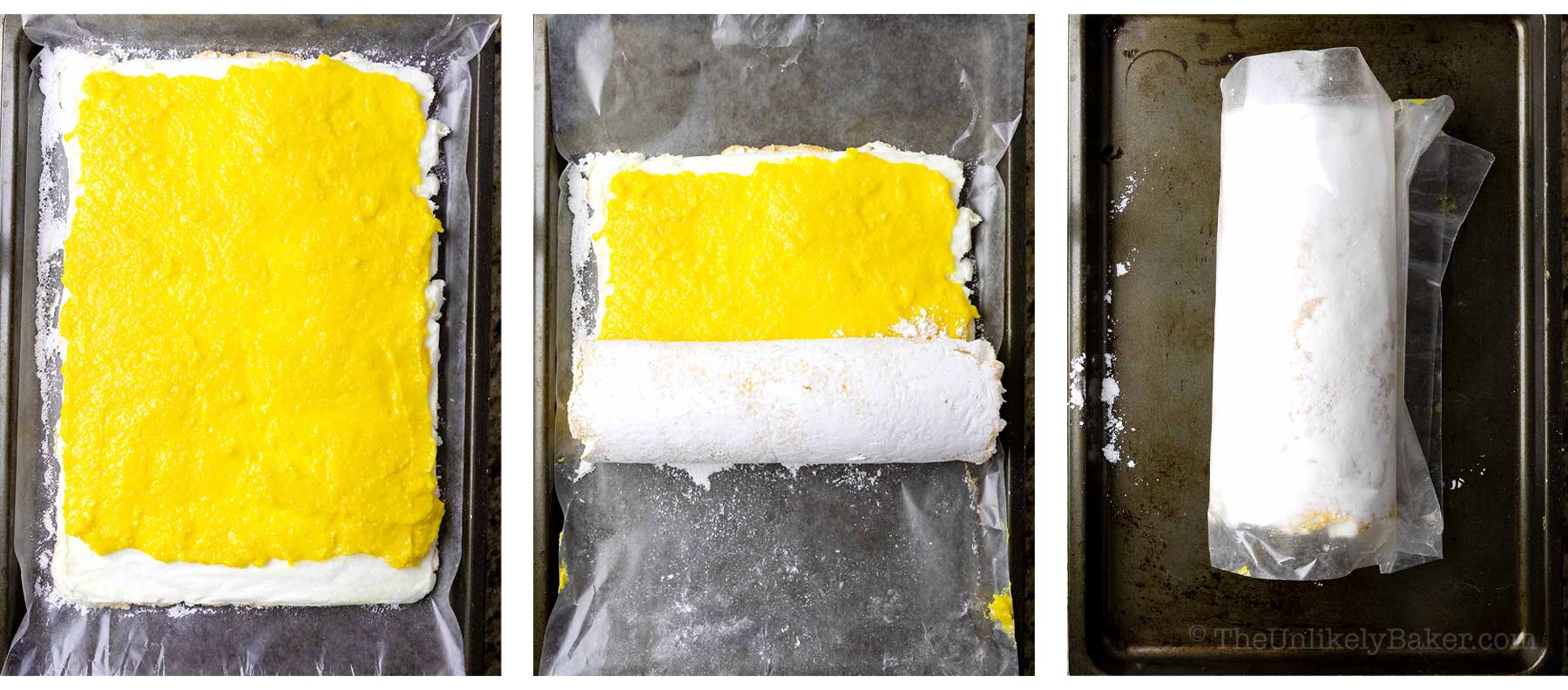
Expert baking tips
Totally doable, right? Here are more tips for perfect Brazo de Mercedes every time.
Tips when making the custard
First tip: stir your custard constantly.
This will help avoid scrambling the eggs, burning the custard, and will also help you get a smoother consistency. You can also use a double boiler.
Speaking of consistency, how thick or runny you want to make the custard or yema is totally up to you. Ideally:
- It’s not so runny that it will drip off the cake.
- It’s thick but still easily spreadable
- But not too thick that it becomes too sticky and ends up breaking the meringue as you spread it on.
Another thing to remember: the custard will continue to thicken as it cools. So don’t try to achieve your desired consistency on the stove or you might end up with yema candy.
I used to cook my custard too thickly but now I tend to go for a runnier custard closer to the consistency of strawberry jam, not ube jam.
Tips for the perfect meringue
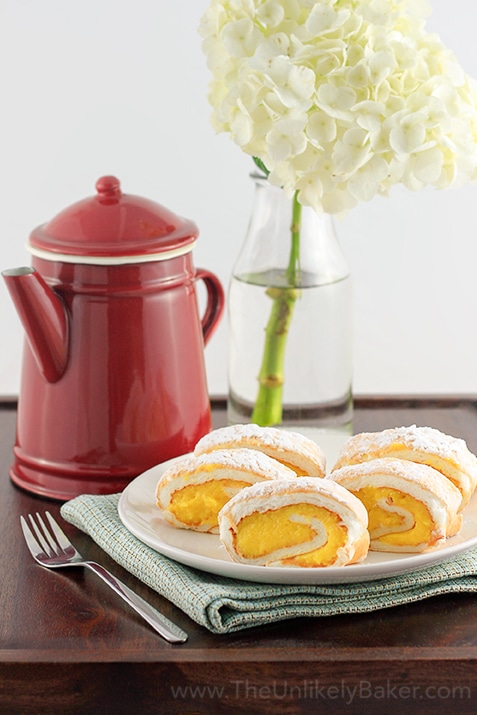
As you can see from the photo above, my meringue used to deflate when making brazo (yes, it looked very sad).
Through the years, I’ve found that, among other things, patience is key to a stable meringue that won’t deflate on you.
For the perfect meringue:
- Make sure your equipment is grease-free. This means your bowl and whisk. And better to use stainless steel or glass bowls instead of plastic ones because plastic can hide traces of oil that we can’t see. For good measure, I wipe my bowl and whisk with a paper towel with a little bit of white vinegar before using. It also helps ensure my equipment are dry before using them.
- Use room temperature egg whites. They whip better and result to a more stable meringue.
- But separate your eggs while still cold. While you need your egg whites at room temperature, it’s easier to separate the eggs while they’re still cold. This way too, you can better avoid getting bits of egg yolks in your egg whites accidentally.
- Practice patience. And like I said, patience is key. Don’t go higher than medium speed (using my KitchenAid stand mixer, I stay on speed 3) when whipping your egg whites. It takes longer to get stiff peaks but this results to a more stable meringue that won’t deflate after baking.
- Add sugar a little a time. In line with our patience theme, add sugar a little at a time. I do about a teaspoon at a time then allow several seconds to pass before adding again. Ideally, you want sugar to dissolve before adding the next teaspoon. A quick test would be to rub some meringue between your fingers. If you still feel significant grains of sugar in there, you should keep going.
Tips when rolling the cake
Rolling cakes are always scary. It might break, it might stick, it might unroll. Happily, for Brazo de Mercedes, we can cover any imperfections with powdered sugar.
Some things that can help things go more smoothly:
- Don’t over bake the meringue. We don’t want it firmer that it needs to be as it will surely crack as we roll it.
- Thoroughly sprinkle the meringue with confectioner’s sugar. This prevents the cake from sticking on the wax paper.
- Handle the meringue gently. Use the wax paper to roll and push the cake over so it doesn’t stick to your fingers.
- Roll the cake tightly but don’t press down.
Troubleshooting guide
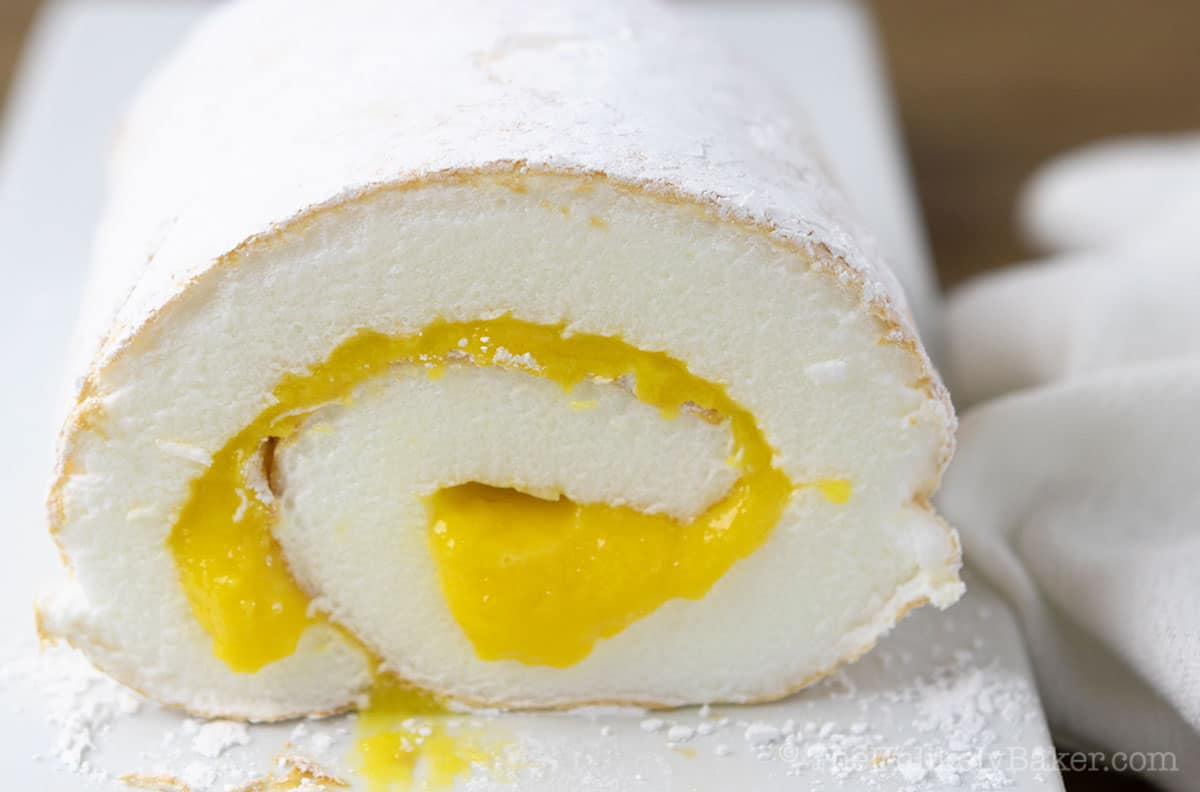
My meringue deflated
It’s common for meringue to deflate a little bit after baking but if yours deflated by a lot, it’s most likely due to egg whites beaten too quickly or on too high a speed.
When this happens, big unstable air bubbles form within the meringue and these same bubbles collapse, causing the meringue to deflate.
Solution: whip your egg whites at a steady, low-medium speed.
My meringue has bubbles on it
Those bubbles are what’s called beading.
They are little sugary drops of moisture that form on top the meringue (if you look closely at the picture of my baked meringue above, you’ll see some beading happening) and usually result from overcooking.
Solution: I don’t worry about beading so much because we cover that side with confectioner’s sugar but if you want a perfectly smooth meringue, watch your meringue closely and ensure you’re baking at the correct temperature.
My meringue is watery
Watery meringue (or weeping) is more often seen in meringue pies and refers to the layer of moisture that forms between the meringue topping and the pie filling after chilling.
But it can happen to Brazo de Mercedes too. Moisture can form between the meringue and the custard.
Common causes range from an unstable meringue to undercooking to a meringue that simply has too much moisture in it.
Some solutions include:
- Don’t make meringue on humid days. It tends to absorb the moisture in the air.
- Don’t over-bake.
- And ensure the sugar dissolves completely.
My meringue cracked
It happens to the best bakers. After following all the steps meticulously, we take the meringue out of the oven and it cracks or breaks. It’s usually a result of the sudden change in temperature.
Solution: turn the oven off once the meringue is cooked but leave it inside with the oven door slightly open to allow the baked meringue to cool gradually.
Recipe FAQs
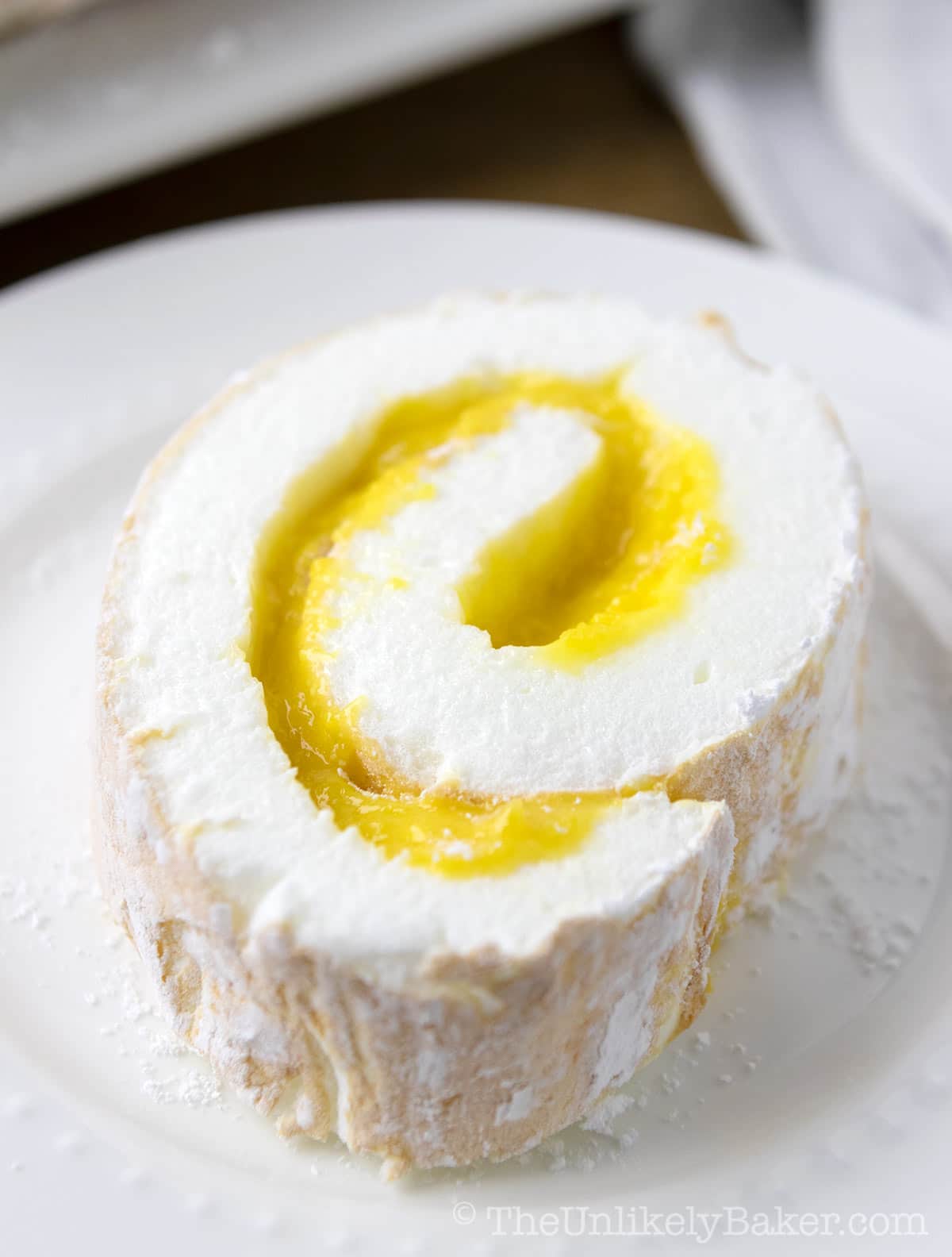
Brazo de Mercedes is best served and eaten the day it’s made. Keep it wrapped in wax or parchment paper on your counter in the meantime.
I don’t recommend putting your cake in the fridge because our home fridges most likely have too much moisture in them causing the meringue to weep and become very soggy.
If you’re wondering how bakeshops like Red Ribbon and Goldilocks manage to keep their brazo dry and chilled, they’re probably using cake display refrigerators where the temperature and humidity are very specific to cakes so they can stay fresh.
If dealing with leftovers, you must refrigerate them in a covered container because of the custard, but again note that they will get softer as they sit.
You can serve Brazo de Mercedes in slices or as a whole cake and have guests slice their own. Best to sprinkle it with more confectioner’s sugar before serving for a more polished look.
Other Filipino desserts
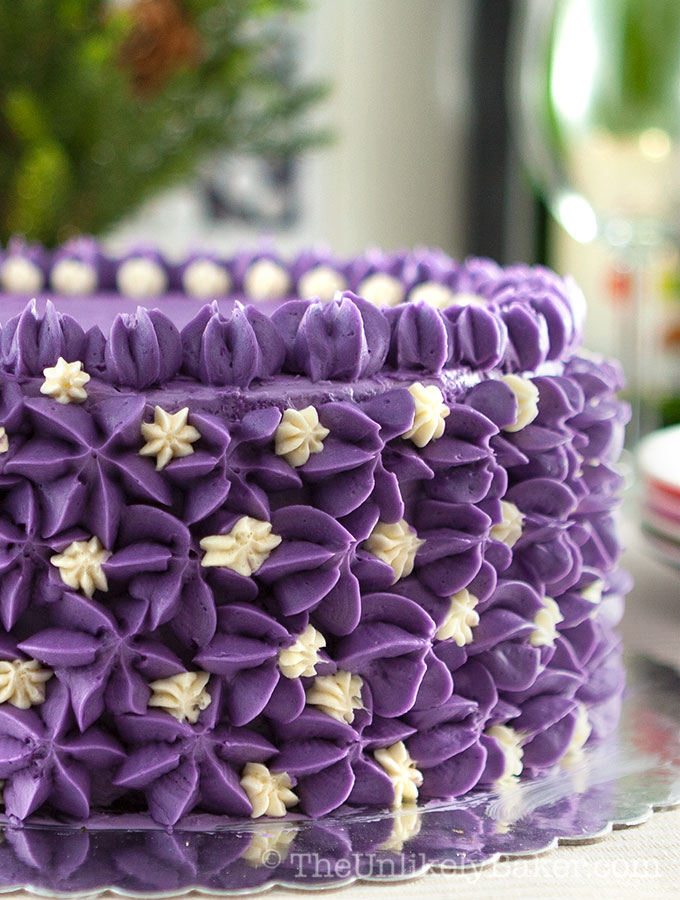
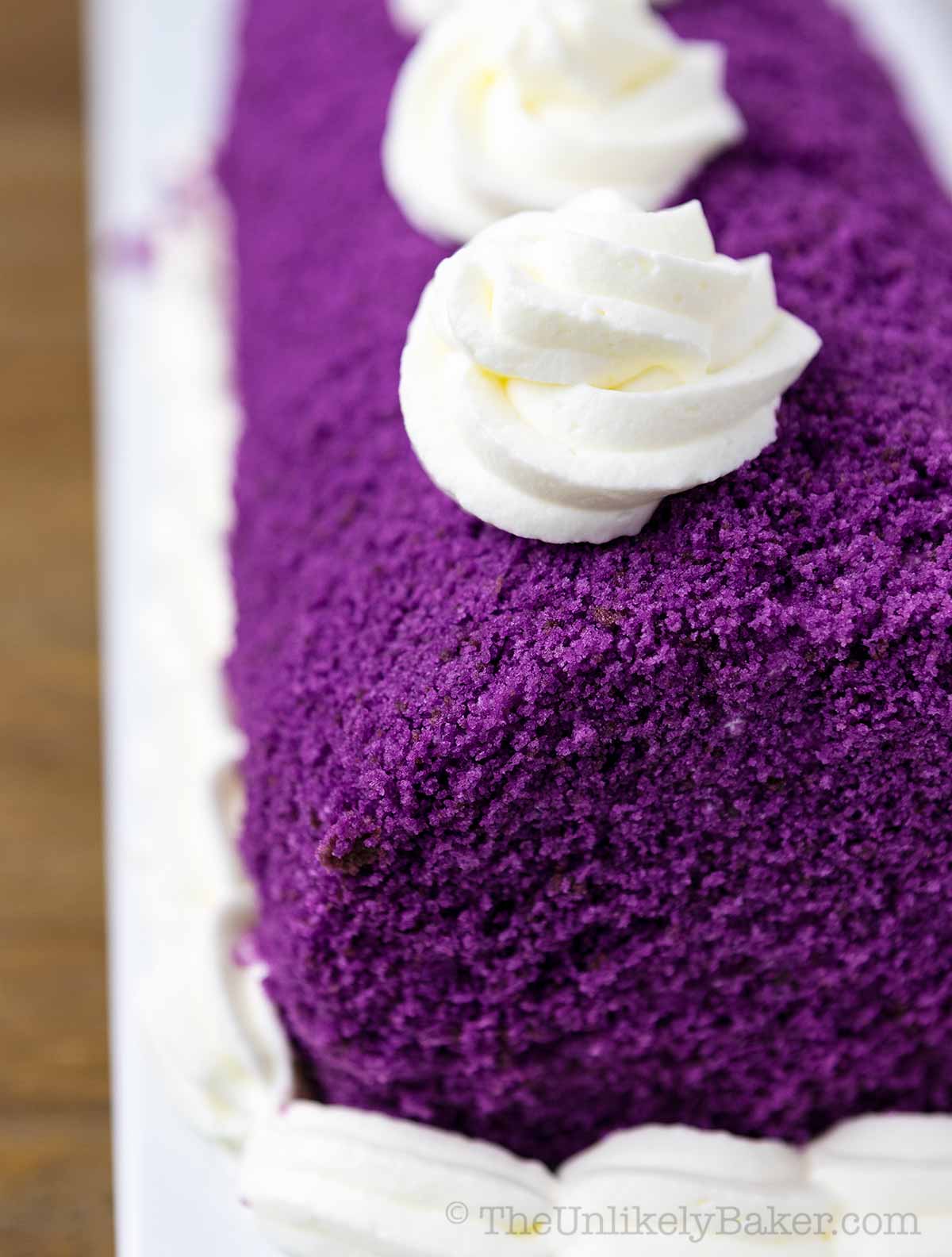
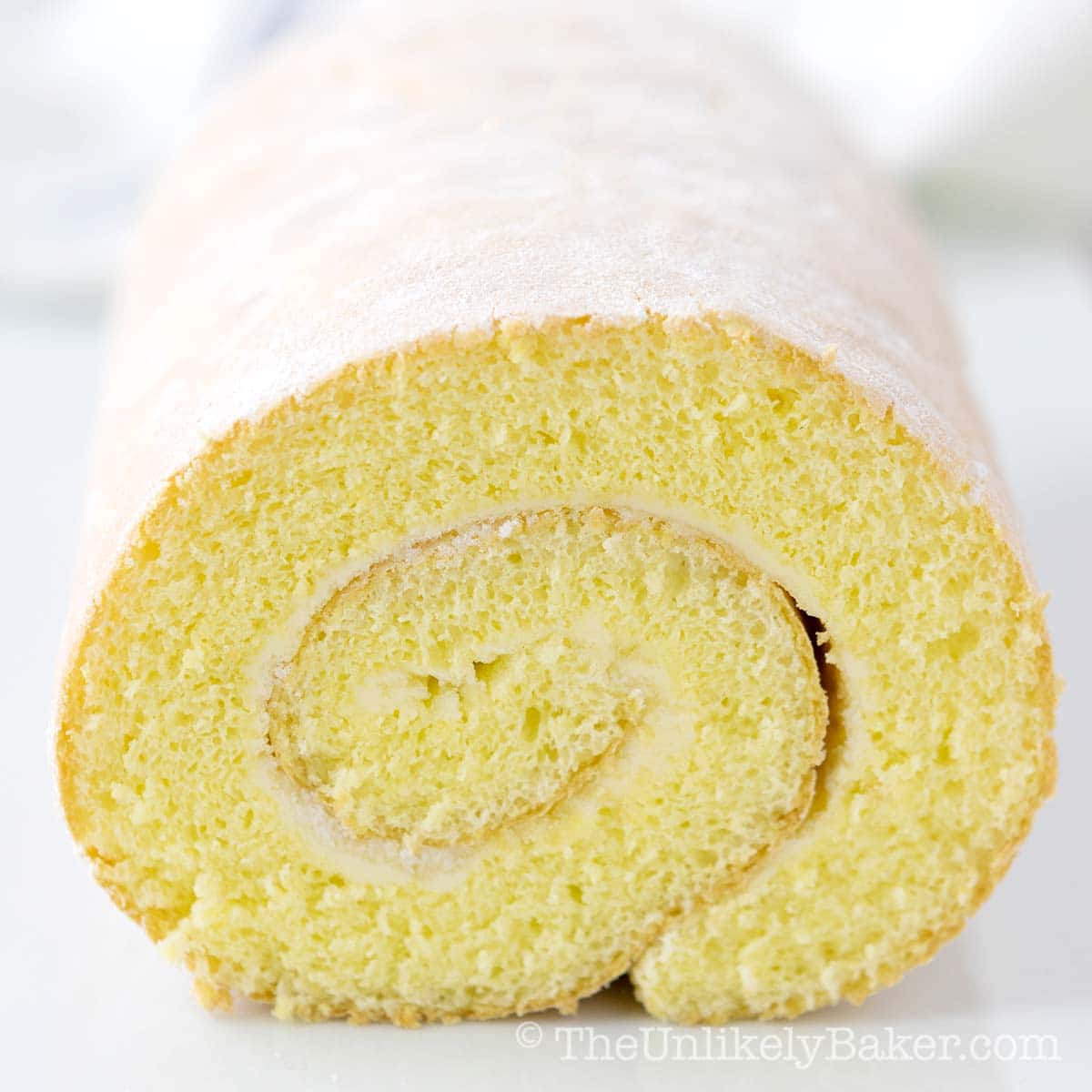
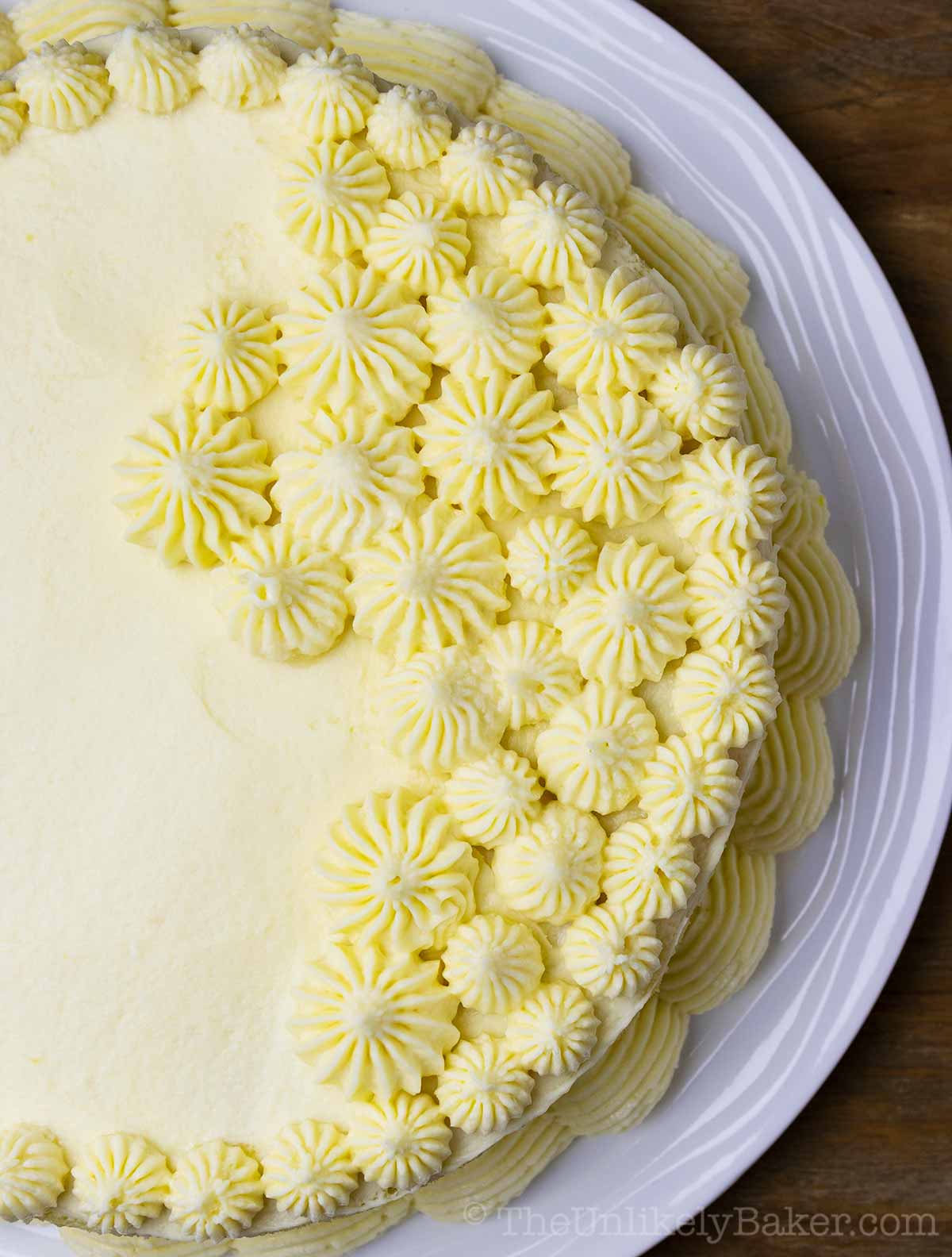
Craving for more Filipino treats? Here are some reader favourites:
- Ube cake with Swiss meringue buttercream
- Ube roll cake with whipped cream cheese frosting
- Easy pianono recipe
- Delicious yema cake with yema frosting
You can find more must-try Filipino desserts here.
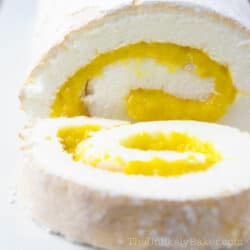
Brazo de Mercedes
Ingredients
For the custard:
- 10 pieces egg yolks from large eggs
- 1 10-oz can condensed milk
- pinch salt
- 1 teaspoon vanilla extract
- 1 teaspoon lime juice or dayap if you can find it
For the meringue:
- 10 pieces egg whites from large eggs room temperature
- ½ teaspoon cream of tartar
- ¾ cup granulated sugar
For dusting:
Instructions
For the custard:
- In a medium heavy-bottom saucepan (don’t turn on the stove yet), combine egg yolks, condensed milk and a pinch of salt.

- Mix them thoroughly then start cooking over low heat. Stir often so you don't accidentally scramble the eggs or burn the custard. Watch closely.
- When you see that your mixture is starting to thicken and take shape, add vanilla and lime juice.
- When you’ve reached custard consistency (thick but still spreadable), turn off the stove, remove pan from heat, transfer the custard to a heat-proof container and set aside to cool.

For the meringue:
- Pre-heat oven to 350F. Prep a 10×15 jelly roll pan by covering it with parchment paper and lightly greasing the parchment paper. Set aside.
- Using a stand mixer with the whisk attachment or in a large bowl using a handheld electric mixer, sprinkle cream of tartar on top of the egg whites and whisk on low-medium speed until foamy.

- Gradually add sugar – about 1 teaspoon at a time – and continue whisking until you reach stiff peaks (see notes).
- Transfer the meringue to your prepared pan and spread evenly. Handle lightly (see notes).

- Bake the meringue for 20 minutes or until the top turns a light brown.

- Turn the oven off, open the oven door slightly but keep the baked meringue inside for another 10 minutes to allow it to cool gradually.
- Take out of the oven and continue cooling on your counter.
Assembly:
- Once the meringue has cooled, run a thin sharp knife around the edges of the pan and dust the top with confectioner’s sugar. Make sure to cover the whole meringue otherwise it will stick once you roll it.

- Place a piece of wax paper on top of the meringue, then cover the meringue with another pan that’s slightly larger than the pan you baked the meringue in.
- Carefully flip the cake, lift the jelly roll pan and gently peel the parchment paper off the meringue.

- Spread the custard evenly then use the wax paper to help you roll the meringue over. Cover in wax paper until ready to serve. Best served immediately.

Video
Notes
- The total yield depends on how thick or thin your slice your Brazo de Mercedes. The estimated nutrition values are based on a serving size of 8.
- You’ll know your meringue is ready and has reached stiff peaks if it stays put and doesn’t slide around when you tilt your bowl.
- Brazo de Mercedes traditionally has a zigzagged surface and you can achieve this by levelling the top of your meringue with a decorating comb or a fork. I personally don’t like doing this because I end up losing a significant amount of meringue so I just skip this step.
- See post for lots of baking tips, a troubleshooting guide, FAQs and step-by-step photos.
Nutrition
Nutritional information are estimates only.
Happy baking!
Did you make this recipe? I’d love to hear from you in the comments section below.
And let’s get social! Find me on Facebook, Pinterest, Instagram, Twitter and YouTube.
(This was the very first recipe published on The Unlikely Baker on 19 January 2016. Updated with new photos and a more comprehensive baking guide on 21 March 2022.)

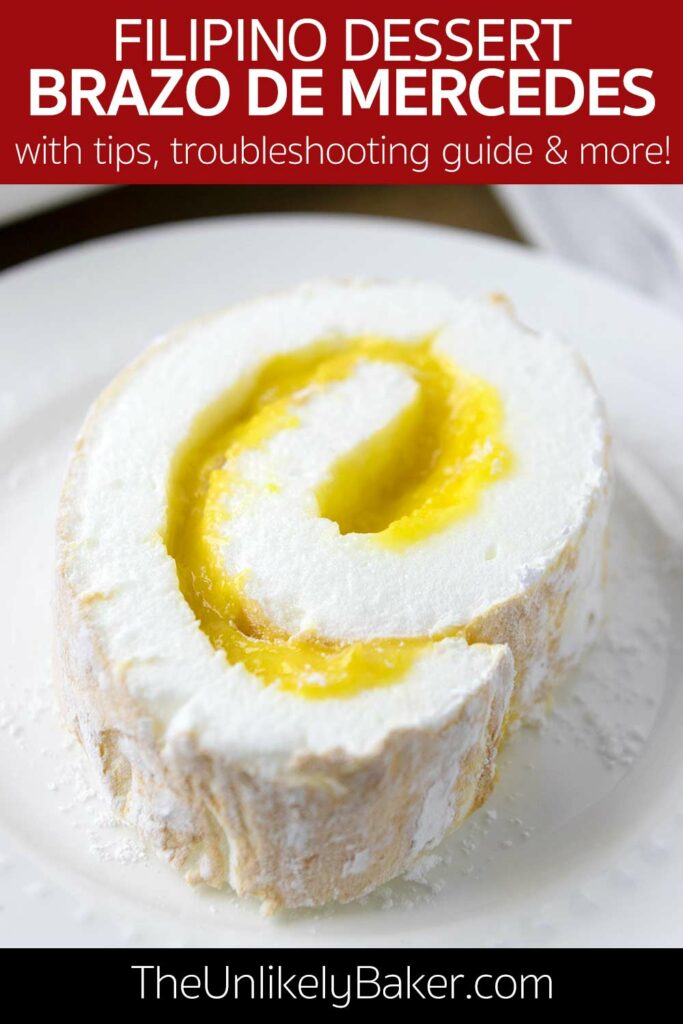
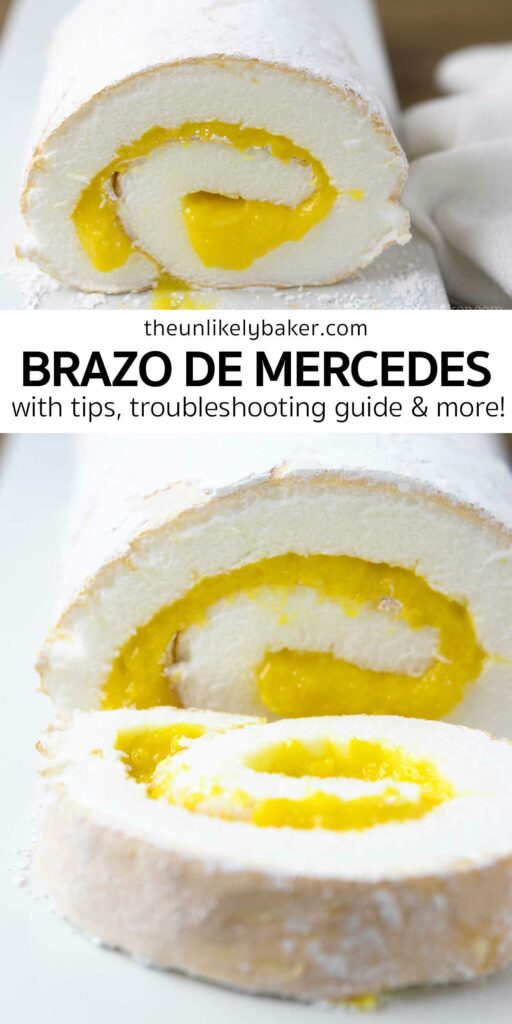
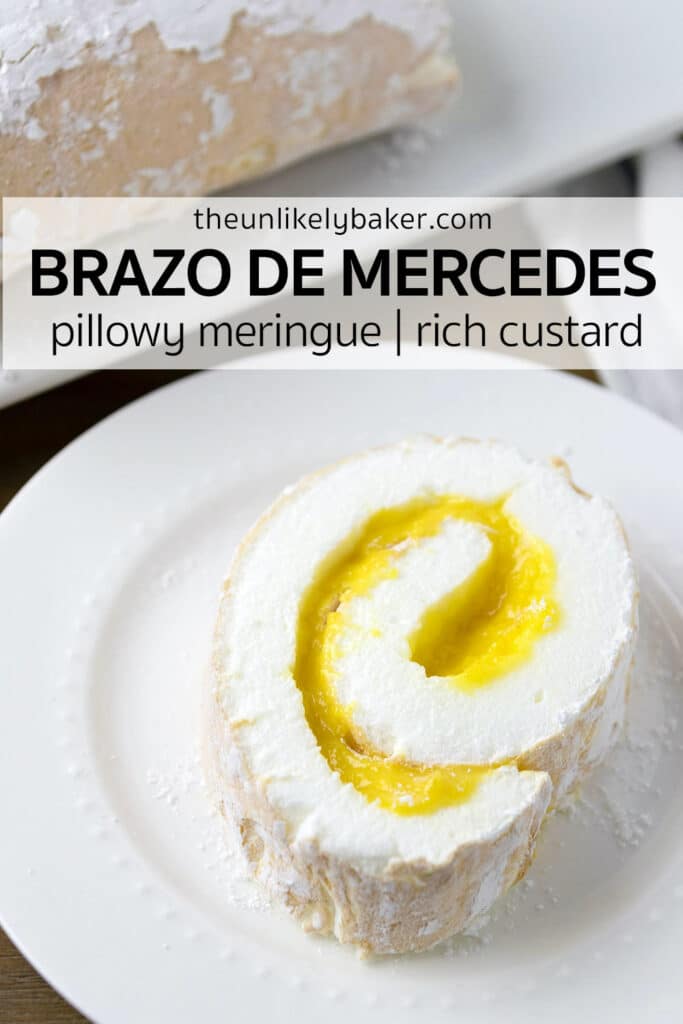
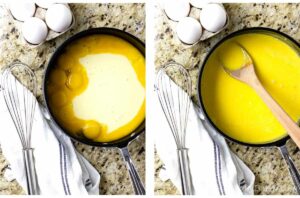
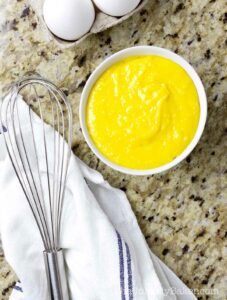
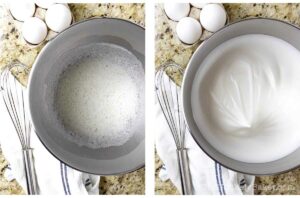
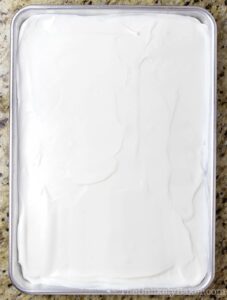
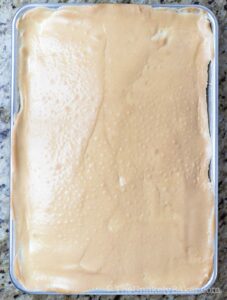
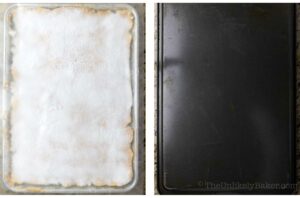
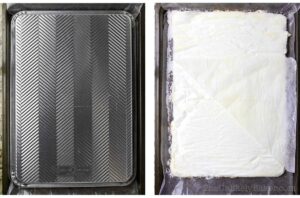
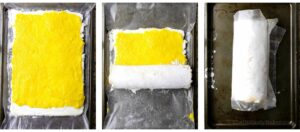
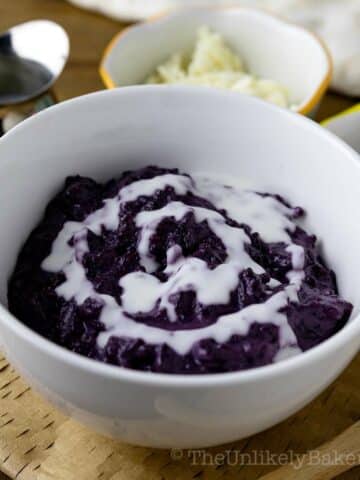
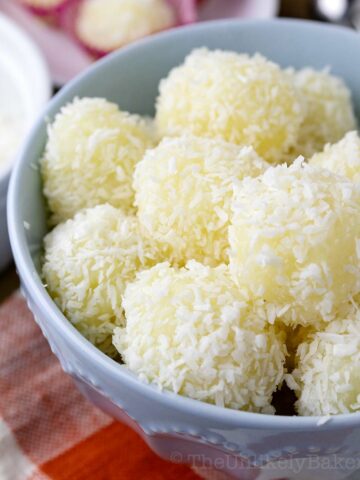
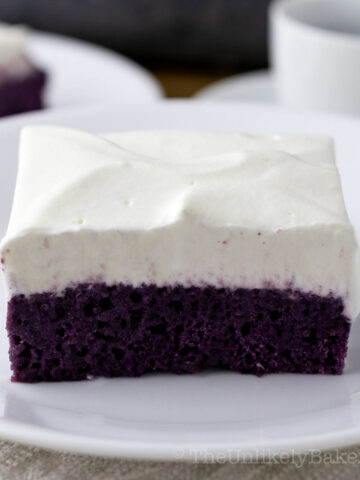
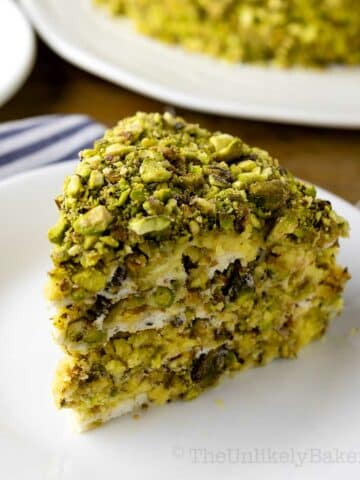
Maria
Thanks so much for sharing your recipe Jolina, my family loves it and my husband was impressed. It wasn’t hard as I thought.
Jolina
Hi Maria! You’re welcome! That was my first thought too when I made this, it’s not as hard to make as it looks 🙂 And it’s totally worth it. Glad you and your family like it!
marja
hi jolina, saw your page in fb and i’ve been looking for this recipe as I have been craving for it. First time I tried to bake and it was a succes 🙂 it’s all because of your tips, thank you so much. My husband almost finished it in 1 day.
Jolina
Hi Marja! So happy to hear that! And you are most welcome 🙂 Brazo de Mercedes is my all time favourite Filipino dessert.
Janice
Honestly, I’d never heard of this dessert, but I love basically anything that is stuffed with custard, especially when the custard is made from condensed milk!
Good for you for persevering to get the recipe right. It’s so demoralizing when things go wrong, but in the end, when it’s right, it feels super!
Jolina
Condensed milk is like a magic ingredient isn’t it? And yes, absolutely agree on feeling like a winner when you finally look at the finished product that looks and tastes right! 🙂
Gloria
This looks amazing. I have never heard of it before….but would LOVE to give this a try as well.
Jolina
I’m so happy to hear that 🙂 Hope you like it!
Diana
Wow it’s my first time seeing this wonderful dessert! I love custard it’s one of my favourite things ever, so it sounds like my kind of dessert. Will have to try this!
Jolina
Hi Diana, hope you like it! 🙂
Sara
I had neer heard of Brazo de Mercedes before. Meringue and egg custard would be such a wonderful combination, I can understand your cravings.
Jolina
Not very many people have…Filipino cuisine hasn’t really gone mainstream. But I hope more people try it 🙂
Mica
This will be my first time trying this recipe, and I look forward to it. I am very fond of lemon meringue!
Jolina
Not very many people know about Filipino cuisine but I really hope they try. I may be biased (lol) but it’s really good 🙂 Thanks for stopping by!
Sandra
Light and fluffy! I want to jump in and grab a piece! This would be a lovely dessert for Easter!
Jolina
They would be 🙂 Thanks Sandra!
Marissa
This looks incredible! I’ve started baking more outside of my comfort zone recently and it’s been quite the adventure. The best part though is when you figure out THE recipe. <3 Great post, Jolina!
Jolina
I love trying different cuisines too. It is an adventure isn’t it? 🙂 Thanks Marissa!
Michele
Ive had this at a friends house and have always wanted to make it. I can’t wait to surprise them and make them something that is one of their families traditions! It looks so beautiful!
Jolina
I’m so glad you liked it. Not very many people are familiar with Filipino cuisine. And yes, that will be a really nice surprise 🙂
Carla
I can’t believe this is one of your first baking recipes! It looks BEAUTIFUL and I especially love the tips you shared, you totally sound like a pro. Thank you for sharing, this looks delicious and I’d love to try it!
Jolina
Thanks Carla! Google is my friend 🙂 I just experiment and experiment. I hope you try and like it!
Rose Pascua
Hi! I see you have added lime juice to the custard. Will it lessen the eggy taste of the custard? The recipe I’ve tried before has no lime and it is too eggy. How can I change it? Thanks
Jolina
Hi Rose! The custard doesn’t taste eggy at all. It’s sweet and rich because of the condensed milk so I add the lime juice more to cut that sweetness. Just make sure to constantly stir when you’re making your your custard so you don’t scramble your egg yolks…maybe that’s where the eggy taste is coming from? I also add the vanilla towards the end so it doesn’t evaporate completely. Hope this helps!
Rose Pascua
Thanks, I’ll try again
Winnie
These looks soooooooo tasty and they’re so unique!
I wish I could grab one right now and eat 🙂
Jolina
They are quite unique 🙂 I was told they were like jelly rolls but since I haven’t had jelly rolls before I really can’t tell for sure lol. Thanks for stopping by! And do tell me how it goes when you try the recipe.
Kristina Hudson
This looks wonderful- and perfect for a fun Spring dessert! I’ll definitely try this one!
Oh- and one tip for working with egg whites that I thought of to add to your list: do not EVER use a plastic bowl to beat the egg whites. It sounds crazy, but the molecular structure of plastic so closely resembles that of the egg whites that it will interfere with how well they whip. Steel is great and copper is preferred 🙂 Happy baking!
Jolina
That’s a great tip, thank you! And thanks for stopping by 🙂
Lynne
I LOVE this!! I think you are well on your way here, Jolina! Your food sounds amazing and your pictures are great! I seriously want to make this – it looks and sounds delicious!!
Keep up the great work. I look forward to lots more!
Jolina
Thank you so much Lynne! That means a lot. I’m really inspired by bloggers like you. And I’m slowly realizing that like you, I also want to be a blogger when I grow up 🙂 Thanks for stopping by!